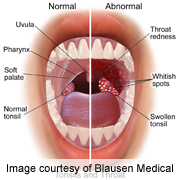- Skip Storing This Everyday Product in the Fridge Door
- Green Tea + B3 Pairing May Boost Brain Health
- Navigating Your Midlife Crisis: Embracing New Possibilities
- City Raccoons Showing Signs of Domestication
- Mapping the Exposome: Science Broadens Focus to Environmental Disease Triggers
- One Week Less on Social Media Linked to Better Mental Health
- Your Brain Changes in Stages as You Age, Study Finds
- Some Suicide Victims Show No Typical Warning Signs, Study Finds
- ByHeart Formula Faces Lawsuits After Babies Sickened With Botulism
- Switch to Vegan Diet Could Cut Your Greenhouse Gas Emissions in Half
HPV-Linked Throat Cancer May Have Telltale First Symptoms


The first symptoms of throat and mouth cancer — also known as oropharyngeal cancer — may differ depending on whether the condition is caused by the human papillomavirus (HPV), a small study suggests.
Oropharyngeal cancer arises in the throat, soft palate, tonsils or base of the tongue. Smoking is a major risk factor, as is chronic infection with certain strains of HPV — which causes warts in the genitals, mouth and anus, and is the most common sexually transmitted disease in the United States.
Although oropharyngeal cancer is relatively uncommon, the rate of HPV-linked cases has been rising — particularly among white adults younger than 55. The reasons aren’t clear, but experts suspect that changes in oral sex practices have a lot to do with it.
The U.S. Centers for Disease Control and Prevention estimates that each year about 8,400 Americans are diagnosed with HPV-related oropharyngeal cancer.
“We’re seeing this in younger, healthy people who don’t smoke,” said Dr. Terry Day, senior researcher on the new study and a specialist in head and neck cancers at the Medical University of South Carolina, in Charleston.
Despite the concerning rise in oropharyngeal cancers, Day said, there has been a lack of research into the initial symptoms — including whether the signs of HPV-linked tumors are distinct.
So his team looked at records for 88 patients diagnosed with oropharyngeal cancer at their center between 2008 and 2013. Most — 71 — had HPV-positive cancer, and for them the most common first symptom was a lump in the neck.
Half of those patients had a “mass” in the neck, versus only 18 percent of patients with HPV-negative cancer, Day’s team reported in the March 20 online issue of JAMA Otolaryngology–Head & Neck Surgery.
For the patients without HPV infection, a persistent sore throat and difficulty swallowing were the most common first signs. More than half complained of a sore throat, while 41 percent had problems with swallowing.
Some patients with HPV-linked cancer had those symptoms, too, but less commonly: 28 percent had a stubborn sore throat, and only 10 percent had trouble swallowing, the findings showed.
An expert who reviewed the study called the findings “interesting,” but said they should be interpreted with caution.
Larger studies are needed to confirm the results, said Maria Worsham, research director in the department of otolaryngology/head and neck surgery at Henry Ford Hospital, in Detroit.
Plus, Worsham said, the symptoms these study patients reported are not unique to cancer. So people should not assume that a lump in the neck means they have cancer — or oral HPV, she said.
Another expert not involved with the study said that a lump could indeed be an infection that just needs a round of antibiotics.
But if the mass persists, see your doctor again, added Dr. Dennis Kraus, director of the Center for Head and Neck Oncology at Lenox Hill Hospital, in New York City.
According to Kraus, the findings help “codify” what many doctors have noted: that people with HPV-positive oropharyngeal cancer tend to have no symptoms, but instead notice a lump.
The “good news,” Kraus said, is that HPV-positive cancers generally have a better prognosis. Patients with HPV-negative cancers tend to have a more-aggressive disease — and, therefore, obvious symptoms like an irritated throat and difficulty swallowing.
Kraus agreed with Day that the face of oropharyngeal cancer has changed from years ago. HPV-positive tumors are now more common than HPV-negative ones, he said.
According to the CDC, about 7 percent of Americans have oral HPV, though only 1 percent have the particular strain (HPV-16) that’s linked to oropharyngeal cancer.
Usually, the immune system is able to clear HPV from the body, and most people never know they were infected.
But for reasons that aren’t clear, some people harbor chronic HPV infections. Persistent infection with a cancer-linked strain is the big worry: Nearly all cases of cervical cancer, for instance, are caused by HPV.
There are, however, two vaccines against the most common cancer-linked HPV strains — including HPV-16. Experts recommend all children ages 11 and 12 be vaccinated. Older girls and women up to age 26 should get “catch-up” shots if they’ve never been vaccinated. The same advice goes for boys and men ages 13 to 21.
The vaccines — Gardasil and Cervarix — are known to ward off genital and anal HPV infections. Studies on whether the vaccines prevent oral infections are just starting. But, Kraus noted, they do target the major HPV strain linked to oropharyngeal cancer.
More information
Learn more from the Head and Neck Cancer Alliance.
Source: HealthDay
Copyright © 2025 HealthDay. All rights reserved.










